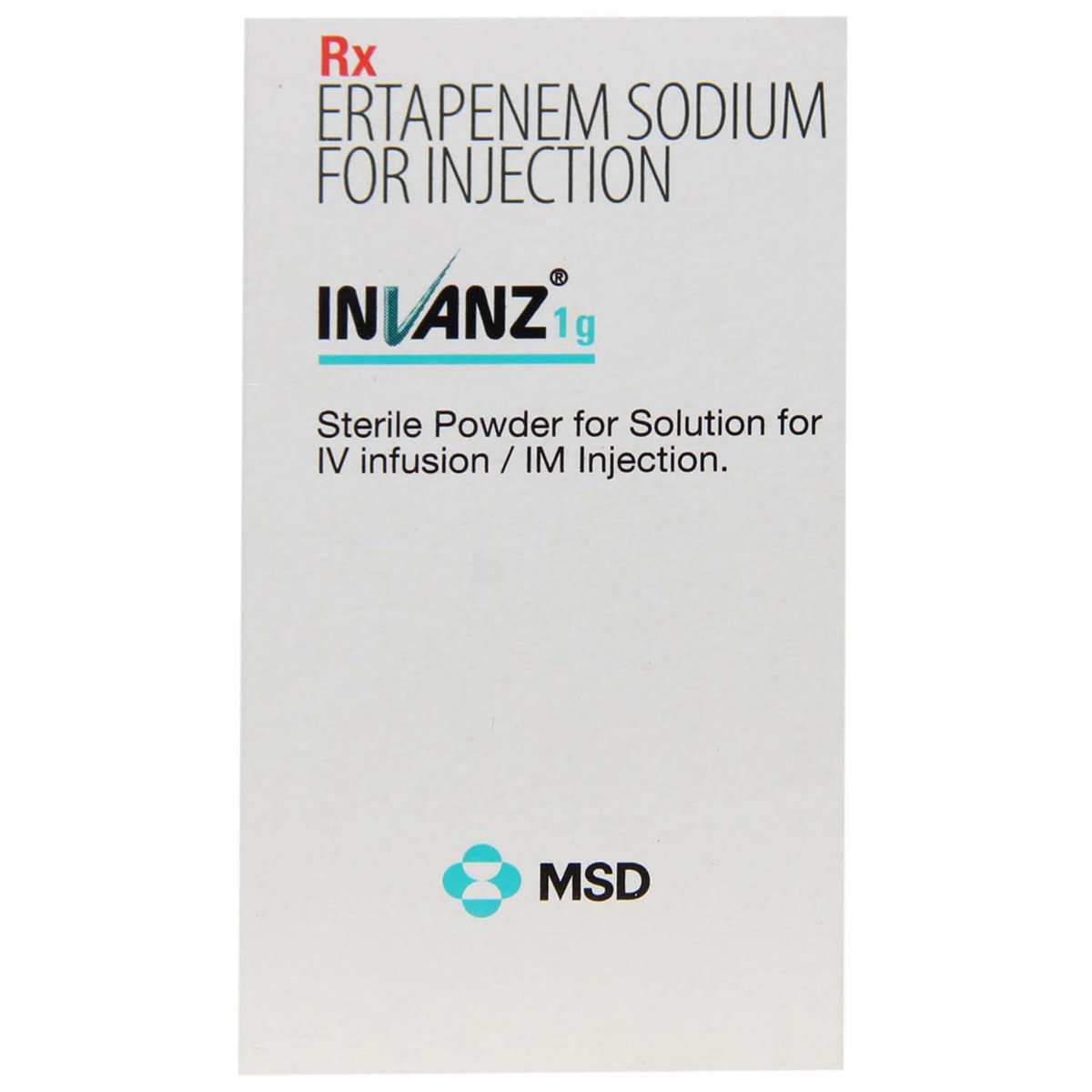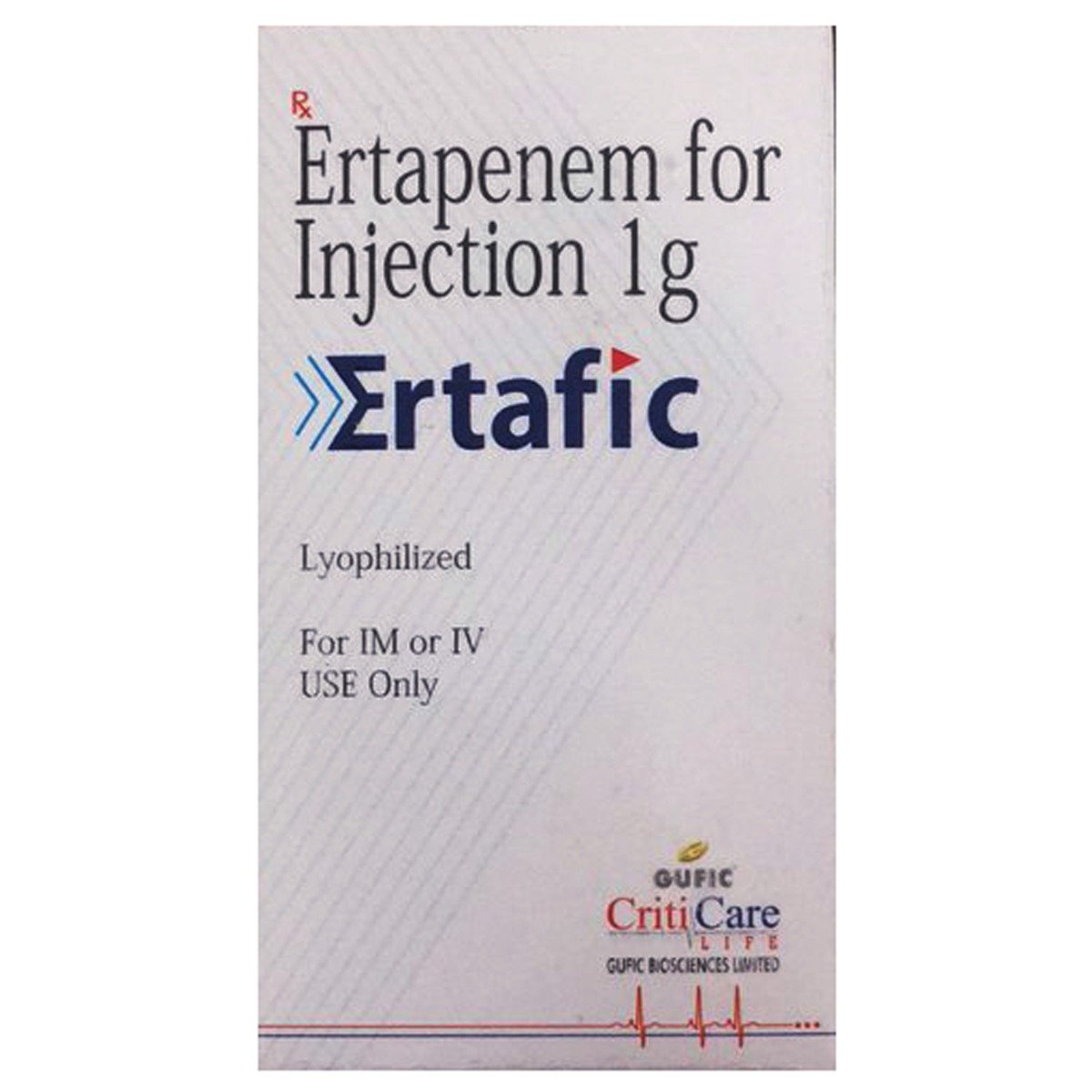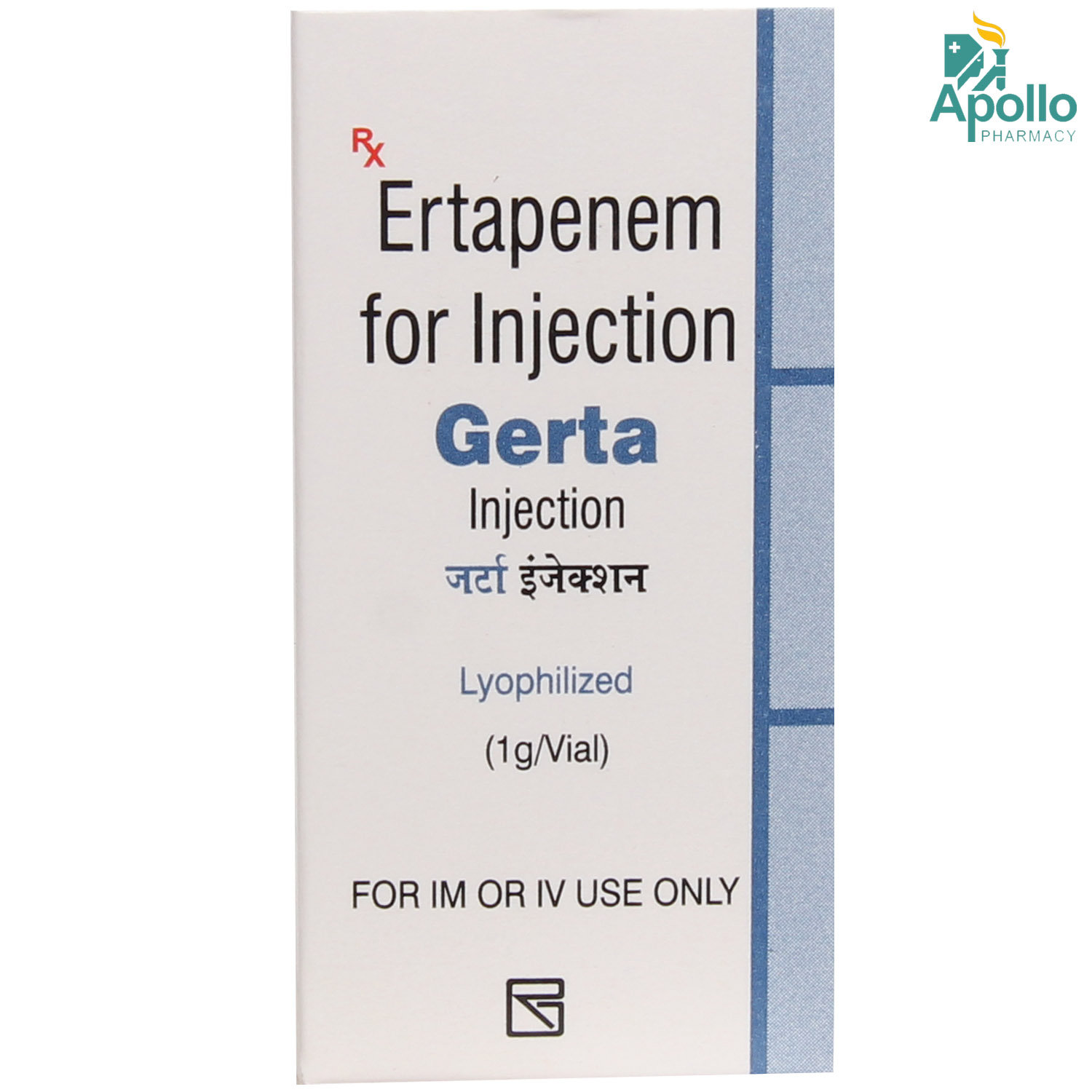Ertacrit 1gm Injection
MRP ₹2450
(Inclusive of all Taxes)
₹367.5 Cashback (15%)
Provide Delivery Location
Online payment accepted
 Prescription drug
Prescription drugWhats That
Composition :
Manufacturer/Marketer :
Consume Type :
Return Policy :
About Ertacrit 1gm Injection
Ertacrit 1gm Injection belongs to a class of medications called ‘antibiotics’ used to treat bacterial infections. It can be used to treat intra-abdominal (stomach) infections, skin infections such as diabetic foot infections, community-acquired pneumonia (lung infection), and acute (short-term) gynaecological infections such as urinary tract infections and pelvic infections. It is also used to prevent surgical site infections in patients who have undergone surgery on the colon or rectum.
Ertacrit 1gm Injection contains ‘Ertapenem’, which belongs to the class of ‘carbapenem antibiotics. It has bactericidal action and kills the bacteria that are causing the infection. It works by destroying the cell wall (outer layer of the bacteria), which is essential for its survival. Ertacrit 1gm Injection does not work against infections caused by viruses.
Ertacrit 1gm Injection is available in the form of injection and infusion. You should take this medicine exactly as prescribed by your doctor. The common side-effects of Ertacrit 1gm Injection are nausea, vomiting, diarrhoea, headache, and injection site pain. These side effects are usually mild and temporary. However, if these side effects persist or worsen, inform your doctor immediately.
Do not take Ertacrit 1gm Injection if you are allergic to ‘Ertapenem’ or antibiotics such as penicillins, cephalosporins, and carbapenems. Before taking Ertacrit 1gm Injection, inform your doctor if you have diarrhoea, brain disorders such as seizures (fits), have been taking valproic acid medicine for treating seizures, have kidney failure, and be on a controlled sodium diet. Also, inform your doctor if you are pregnant or breastfeeding. Do not use Ertacrit 1gm Injection in children below 2 years of age. In the elderly, dosage adjustments may not be necessary except in patients with kidney failure. Ertacrit 1gm Injection may not interact with alcohol. Ertacrit 1gm Injection may cause dizziness (less common), so do not drive or operate heavy machinery if you feel dizzy.
Uses of Ertacrit 1gm Injection
Directions for Use
Key Benefits
Ertacrit 1gm Injection contains ‘Ertapenem’, which belongs to the class of ‘carbapenem antibiotics. It is used in the treatment of high-risk or serious bacterial infections. Ertapenem has bactericidal action and works by killing the bacteria causing the infection. It interferes with the formation of the cell wall, which is essential for the bacteria's survival. It has a broad spectrum of activity and is active against both gram-positive and gram-negative bacteria. It can act against various bacterial strains, such as Enterobacteriaceae (cause infections in healthcare settings), Streptococcus pneumonia (cause community-acquired pneumonia), and anaerobic bacteria, which are common causes of serious infections.
Storage
- Inform Your Doctor: Notify your doctor immediately about your diarrhoea symptoms. This allows them to adjust your medication or provide guidance on managing side effects.
- Stay Hydrated: Drink plenty of fluids to replace lost water and electrolytes. Choose water, clear broth, and electrolyte-rich drinks. Avoid carbonated or caffeinated beverages to effectively rehydrate your body.
- Follow a Bland Diet: Eat easy-to-digest foods to help firm up your stool and settle your stomach. Try incorporating bananas, rice, applesauce, toast, plain crackers, and boiled vegetables into your diet.
- Avoid Trigger Foods: Steer clear of foods that can worsen diarrhoea, such as spicy, fatty, or greasy foods, high-fibre foods, and dairy products (especially if you're lactose intolerant).
- Practice Good Hygiene: Maintain good hygiene to prevent the spread of infection. To stay healthy, wash your hands frequently, clean and disinfect surfaces regularly, and avoid exchanging personal belongings with others.
- Take Anti-Diarrheal Medications: If your doctor advises, anti-diarrheal medications such as loperamide might help manage diarrhoea symptoms. Always follow your doctor's directions.
- Keep track of your diarrhoea symptoms. If they don't get better or worse or are accompanied by severe stomach pain, blood, or dehydration signs (like extreme thirst or dark urine), seek medical help.
- Inform your doctor about the nausea and discuss possible alternatives to the medication or adjustments to the dosage.
- Divide your daily food intake into smaller, more frequent meals to reduce nausea.
- Opt for bland, easily digestible foods like crackers, toast, plain rice, bananas, and applesauce.
- Avoid certain foods that can trigger nausea, such as fatty, greasy, spicy, and smelly foods.
- Drink plenty of fluids, such as water, clear broth, or electrolyte-rich beverages like coconut water or sports drinks.
- Use ginger (tea, ale, or candies) to help relieve nausea.
- Get adequate rest and also avoid strenuous activities that can worsen nausea.
- Talk to your doctor about taking anti-nausea medication if your nausea is severe.
- Record when your nausea occurs, what triggers it, and what provides relief to help you identify patterns and manage your symptoms more effectively.
- Hydrate your body: Drink enough water to prevent dehydration and headaches.
- Calm Your Mind: Deep breathing and meditation can help you relax and relieve stress.
- Rest and Recharge: Sleep for 7-8 hours to reduce headache triggers.
- Take rest: lie down in a quiet, dark environment.
- Cold or warm compresses can help reduce tension.
- Stay Upright: Maintain good posture to keep symptoms from getting worse.
- To treat headaches naturally, try acupuncture or massage therapy.
- Over-the-counter pain relievers include acetaminophen and ibuprofen.
- Prescription Assistance: Speak with your doctor about more substantial drug alternatives.
- Severe Headaches: Seek emergency medical assistance for sudden, severe headaches.
- Frequent Headaches: If you get reoccurring headaches, consult your doctor.
- Headaches with Symptoms: Seek medical attention if your headaches include fever, disorientation, or weakness.
- Your doctor may recommend regular liver function tests (LFT) to monitor liver enzyme levels.
- To support your liver, eat a healthy diet with lots of fruits, vegetables, lean proteins, and healthy fats.
- Avoid eating processed meats, sugary foods, and unhealthy fats.
- Limit your alcohol consumption, since too much can worsen liver function and contribute to high levels of Alkaline Phosphatase (ALP).
- Stay active with regular exercise, drink plenty of water, and try to avoid harmful chemicals that can damage your liver.
- Quit smoking to lower the risk of elevated ALP levels.
- Inform your doctor immediately if you experience a fever after starting a new medication.
- Your doctor may adjust your medication regimen or dosage as needed to minimize fever symptoms.
- Monitor your body temperature to monitor fever progression.
- Drink plenty of fluids, such as water or electrolyte-rich beverages, to help your body regulate temperature.
- Get plenty of rest and engage in relaxation techniques, such as deep breathing or meditation, to help manage fever symptoms.
- Under the guidance of your doctor, consider taking medication, such as acetaminophen or ibuprofen, to help reduce fever.
- If your fever is extremely high (over 103°F), or if you experience severe symptoms such as confusion, seizures, or difficulty breathing, seek immediate medical attention.
Drug Warnings
Do not take Ertacrit 1gm Injection for prolonged periods as long-term use may cause superinfection (additional infection caused by other microbes). Ertacrit 1gm Injection should not be used in patients with diabetic foot infections with ‘osteomyelitis’ (an infection of the bone) as there is no much research regarding the safe use of Ertacrit 1gm Injection in these populations. Ertacrit 1gm Injection should be used with caution in patients with brain disorders such as seizures (fits) as it may worsen the condition. If you experience diarrhoea before, during, or after the treatment, do not take self-medication without discussing it with your doctor. Diarrhoea may also occur due to the inflammation of the colon. Ertacrit 1gm Injection contains sodium, so it should be used with caution in patients on a sodium-restricted diet. Ertacrit 1gm Injection may also cause a change in liver function tests, a change in platelet count, and a change in white blood cell count (in children). So, it is essential to monitor these tests if you are taking this medicine frequently.
Drug-Drug Interactions
Drug-Drug Interactions
Login/Sign Up
Coadministration of Ertacrit 1gm Injection with Divalproex may reduce the blood levels of Divalproex and increase the risk of developing seizures.
How to manage the interaction:
Although there is a possible interaction, Ertacrit 1gm Injection can be taken with Divalproex if prescribed by the doctor. Consult the doctor if you experience loss of seizure control or changes in behaviour. Do not stop using any medications without talking to your doctor.
Co-administration of Metrizamide and Ertacrit 1gm Injection may increase the risk or severity of seizures.
How to manage the interaction:
Co-administration of Ertacrit 1gm Injection and Metrizamide can lead to an interaction, it can be taken if advised by a doctor. However, if you are elderly, undergoing alcohol or drug withdrawal, have a history of seizures, or have a condition affecting the central nervous system such as a brain tumor or head trauma, consult a doctor immediately. Do not stop using any medications without a doctor's advice.
Co-administration of Iomeprol and Ertacrit 1gm Injection may increase the risk or severity of seizures.
How to manage the interaction:
Co-administration of Ertacrit 1gm Injection and Iomeprol can lead to an interaction, it can be taken if advised by a doctor. Do not stop using any medications without a doctor's advice.
Co-administration of Bupropion may rarely cause seizures and combining it with Ertacrit 1gm Injection may increase that risk.
How to manage the interaction:
Although there is a possible interaction, Ertacrit 1gm Injection can be taken with bupropion if prescribed by the doctor. Do not discontinue the medications without consulting a doctor.
When BCG vaccine is used with Ertacrit 1gm Injection, its effectiveness may be reduced.
How to manage the interaction:
Although there is a possible interaction between Ertacrit 1gm Injection and BCG vaccine, you can take these medicines together if prescribed by your doctor. Do not stop using any medications without first talking to your doctor.
The combined use of tramadol with Ertacrit 1gm Injection can make tramadol less effective as a treatment.
How to manage the interaction:
Taking Ertacrit 1gm Injection with tramadol together can possibly result in an interaction, it can be taken if your doctor has advised it. However, if you experience any symptoms such as confusion, hallucination, seizure, increased heart rate, blurred vision, tremors, incoordination, stomach cramps, nausea, vomiting, and diarrhea, contact a doctor immediately. Do not discontinue any medications without consulting a doctor.
The combined use of Ertacrit 1gm Injection and sodium valproate can reduce the blood levels of valproic acid.
How to manage the interaction:
Co-administration of Ertacrit 1gm Injection and sodium valproate can lead to an interaction, it can be taken if advised by your doctor. However, if you experience any symptoms like loss of seizure control or changes in behavior, consult your doctor immediately. Do not discontinue any medications without consulting the doctor.
Drug-Food Interactions
Drug-Food Interactions
Login/Sign Up
Diet & Lifestyle Advise
- Eat healthily. Opt for a balanced and nutrient-rich diet.
- Avoid foods rich in calcium, grapefruit, and grapefruit juice, as they might hinder antibiotic absorption.
- Avoid consumption of alcohol to treat your condition effectively.
- Avoid usage of tobacco.
Side Effects of Ertacrit 1gm Injection
- Nausea
- Vomiting
- Diarrhoea
- Headache
- Stomach pain
- Injection site pain
Habit Forming
Therapeutic Class
All Substitutes & Brand Comparisons
RX
Out of StockNot for online saleERTAZEN INJECTION 1GM
₹769.3
(₹692.37 per unit)
68% CHEAPERRX
Out of StockNot for online saleErtaneon 1gm Injection
Neon Laboratories Ltd
₹2310
(₹2079.0 per unit)
5% CHEAPERRX
Out of StockNot for online saleErtamac 1gm Injection
Macleods Pharmaceuticals Ltd
₹2400
(₹2160.0 per unit)
2% CHEAPER
Drug-Diseases Interactions
Drug-Diseases Interactions
Login/Sign Up
Nearly all antibacterial medications have been associated with Clostridioides difficile-associated diarrhoea (CDAD), formerly known as pseudomembranous colitis, which can range in severity from mild diarrhoea to deadly colitis. Lincomycin and clindamycin are typically to blame. Antibacterial treatment disrupts the colon's normal flora, promoting the growth of C difficile, whose toxins A and B contribute to the emergence of CDAD. When C difficile strains produce hypertoxins, morbidity and death rise; severe infections may not respond to antibiotic therapy and may necessitate colectomy.
How to manage the interaction:
Clostridioides difficile-associated diarrhea (CDAD) has been reported with anti-bacterial agents. Therapy should be administered cautiously in patients with history of gastrointestinal disease, particularly colitis; pseudomembranous colitis.
The kidney is the main organ used to remove carbapenems. Due to slower medication clearance, patients with renal impairment may be more susceptible to carbapenem side effects, such as seizures and other CNS abnormalities. According to the specific product package labelling, dosage variations should be taken into account and be based on the severity of the illness and the degree of renal impairment. Periodic renal function tests should be carried out while receiving treatment.
How to manage the interaction:
Dose adjustment may be needed in patients with kidney problems. Renal function tests should be performed periodically during therapy.
The intravenous use of carbapenems has been linked to deleterious effects on the central nervous system, including hallucinations, somnolence, encephalopathy, myoclonus, tremor, paresthesia, disorientation, agitation, and seizures (up to 1.5%). Regardless of the method of administration, carbapenem therapy should be used with caution in patients who have seizures or other neurologic abnormalities or are at high risk for developing them. In these people, the usual dosage recommendations shouldn't be exceeded. Anticonvulsant medication should be continued in patients with a known seizure disorder while receiving carbapenem medication.
How to manage the interaction:
Therapy should be administered cautiously in patients with or predisposed to seizures or other neurologic disturbances.
Hemodialysis helps to partially eliminate Ertacrit 1gm Injection. A supplement dose of 150 mg is advised to be taken after the dialysis session if the 500 mg daily dose is taken within 6 hours of the procedure. When administered at least 6 hours before hemodialysis, an additional dose is not required.
How to manage the interaction:
Dose adjustment may be needed in patients undergoing dialysis.
FAQs
Drug-Drug Interactions Checker List
- VALPROIC ACID
- PROBENECID
Special Advise
Ertacrit 1gm Injection may cause live bacterial vaccines (such as typhoid vaccine) to not work as well. Do not have any immunizations/vaccinations while using this medication unless your doctor tells you to.
Disease/Condition Glossary
Intra-abdominal infections: It is a broader term used to describe infections associated with the stomach, intestine, peritoneum (lining of the abdominal wall), or other parts present in the abdomen. It mostly occurs due to a complication of another condition, such as appendicitis, following surgery, or a trauma. Symptoms depend on the organ affected or the site of infection. Common symptoms include nausea, vomiting, abdominal pain, and change in bowel habits.
Diabetic foot infections: These are major complications of diabetes. In this condition, the skin tissues break down and expose the inner parts of the skin layer. This diabetic foot infection occurs when the diabetes level becomes uncontrollable. It is one of the most common causes of hospitalization among diabetic patients.
Community-acquired pneumonia: It is called community-acquired as this infection is acquired outside the hospital. It is most commonly caused by the bacteria Streptococcus pneumonia. Symptoms include cough, heavy sputum, shortness of breath, fever, and chills. The risk factors are smoking, age above 65 years, alcoholism, and a weak immune system.
Urinary tract infection (UTI): It is an infection in any part of the urinary system- the kidneys, bladder, or urethra. A bladder infection may cause an increased urge to urinate, pelvic pain, pain during urination, and blood in the urine. A kidney infection may cause tenderness and pain in the back, fever, chills, nausea, and vomiting. The causes of UTI include a weak immune system, kidney stones, enlarged prostate, prolonged use of urinary catheters, diabetes, poor bathroom hygiene, sexual activity, and age.
Pelvic infections: It is also called pelvic inflammatory disease (PID). It is a sexually transmitted infection of the female reproductive organs. Symptoms include pelvic pain, fever, and vaginal discharge.

Have a query?
Alcohol
Safe if prescribed
Ertacrit 1gm Injection may not interact with alcohol. However, it is advised not to consume alcohol as it may interfere with your ability to fight infections.
Pregnancy
Consult your doctor
Ertacrit 1gm Injection is a category B medicine and may not cause harmful effects on the unborn baby. However, your doctor may prescribe this medicine if the benefits outweigh the risks.
Breast Feeding
Consult your doctor
Ertacrit 1gm Injection may get secreted in the breast milk. Your doctor may advise you to stop breastfeeding while using this medicine.
Driving
Safe if prescribed
Ertacrit 1gm Injection may cause dizziness in some cases. So, do not drive or operate heavy machinery if you feel dizzy.
Liver
Consult your doctor
Ertacrit 1gm Injection is probably safe when used in patients with liver diseases. However, if you have liver problems, inform your doctor before taking this medicine.
Kidney
Consult your doctor
Ertacrit 1gm Injection should be used with caution if you have kidney problems. Your doctor may adjust the dose if necessary based on your condition.
Children
Safe if prescribed
Ertacrit 1gm Injection is not recommended for use in children below 2 years of age. Your doctor will decide the dose of Ertacrit 1gm Injection based on your child's age and condition.









